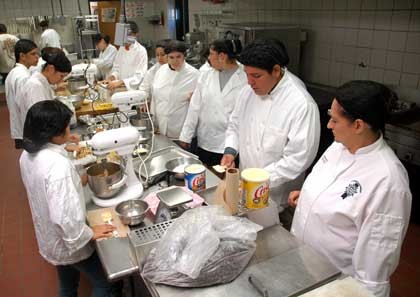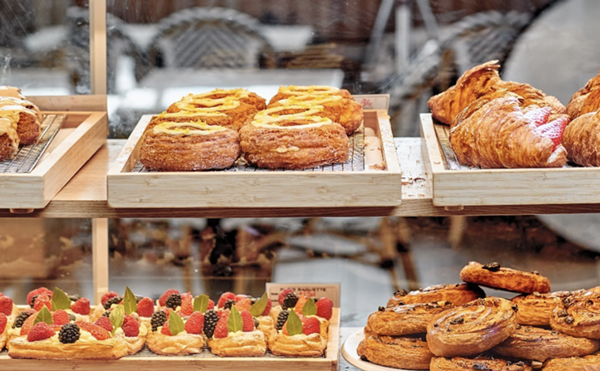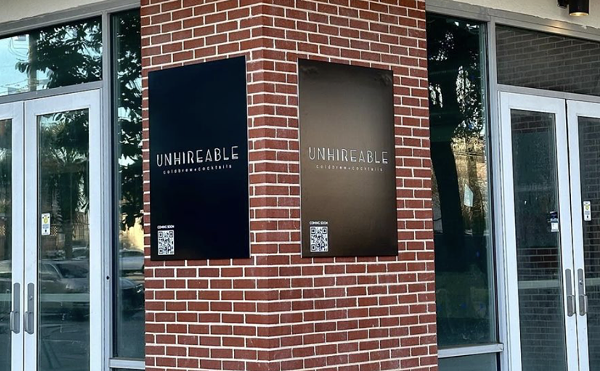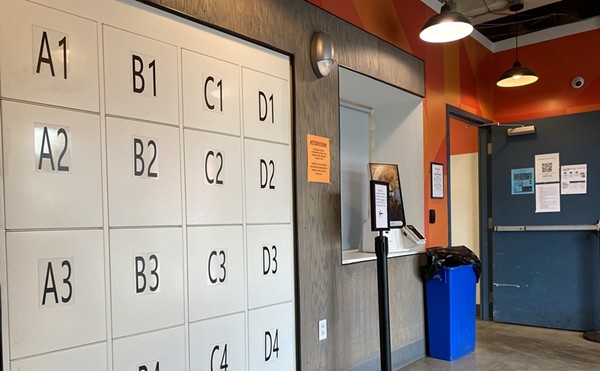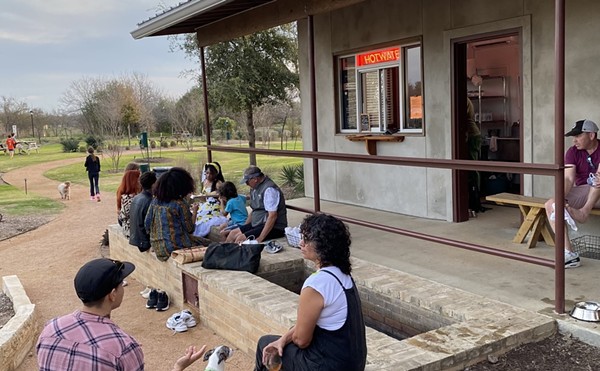In high-school culinary-arts programs, students learn life skills
I can remember the days of traditional Home Economics classes in which my fellow students and I learned to cook such delicacies as meatloaf and to plan meals for small dinner parties of six. Boy, am I old.
Today's high-school foodies flock to culinary programs that put old-school Home Ec to shame. Clark High School, on the North Side, launched its culinary-arts program in the '80s. It fell off the course schedule for a few years in the mid-'90s, but was revived in 1997 with an enrollment of fewer than 20 students. Today, enrollment has increased to nearly 100, and its curriculum is geared toward all areas and levels of the food-service industry, from bussing tables to cooking to management.
| Southwest High School's second-year culinary students assemble around a large work station to prepare chocolate chip cookies. (Photo by Laura McKenzie) |
The program's students operate a campus restaurant where they plan, cook, and serve meals to the faculty, who make reservations for the weekly treat. It's a great lesson in budgeting, says Amy Gonzalez, a teacher in Clark's culinary-arts program, as students must pay for next week's meal with what they earn from this week's. The students prepare a lot of poultry because "chicken is affordable." A recent menu included stuffed chicken breasts with roasted asparagus and parsley potatoes, and a dessert selection of pie, cheesecake, and parfaits.
Clark has also established relationships with area restaurants such as Zio's, EZ's, Joe's Crab Shack, and Macaroni Grill to provide students with real-world experience through internships. "Many of our students do work in the food-service industry during high school and college," says Gonzalez. "They learn employable skills and attributes that will last a lifetime." Clark students have gone on to culinary-arts programs at St. Philip's College, Culinary Institute of America, and Johnson and Wales University.
In 1997, a similar culinary program at Southwest High School was born from a food-production class. "The difference between our food-production class and our culinary program is having teachers with restaurant experience, and the internship activities we've developed for the students," says Judy Beloat the program's director.
The school's culinary-arts program attracts between 80 and 100 students each year, about 50 percent of whom will pursue a culinary career. In addition to internships, the on-campus curriculum is very rigorous, with students presenting 40 to 50 luncheons a year, and catering district awards dinners and faculty and student events, such as the Top 15 Banquet honoring the school's stellar students.
In contrast to the career-oriented programs at Clark and Southwest, the Victory Garden program at the Alamo Achievement Center, San Antonio ISD's alternative high school, is a weekly course in which 20 special-needs students learn about gardening, cooking, the environment, and community.
Local baker Jenny Mattingsley, the Victory Garden's creator and volunteer director, describes the program as rehabilitative. "A lot of kids who otherwise have a tendency to shut down in school want to come work in the garden," she says. "Here they get to work with their teachers and learn outside in the sun, in a practical, hands-on, less formal setting."
The program's centerpiece is a student garden with nine 16-foot beds - planted with seasonal vegetables, herbs, and berries - and a composting area. One week the students work and learn in the garden, the next they cook a family-style meal using freshly harvested ingredients and recipes from around the world. One year, the students corresponded with organic gardeners in Russia, trading magazines, gardening tips, and recipes through the mail. "The most interesting thing was to learn what we had in common," says Tandra Roan, one of three AAC teachers who partner with Mattingsley to run the program. "You know, students were amazed that, even with the difference in climate, a lot of the vegetables and flowers were the same."
| "If the program closes, the kids lose a great mentoring outlet. The Victory Garden introduces them to adults who are doing positive things with their lives, and who are interested in them." - Jenny Mattingsley |
Along with AAC teachers and Mattingsley, the program relies heavily on community volunteers. From a plumber the students learned how to install drip irrigation; from a nutritionist they learned how different cultures organize their food pyramids; and from a master gardener they learned how non-organic fertilizer harms the soil and water supply. This year, Mattingsley hopes to expand the program to include three greenhouses, which SAISD bought for the program last year, and volunteer projects - such as planting a garden at a local convalescent home.
Mattingsley says the Victory Garden program, now in its fourth year, "has been relatively inexpensive" to run. SAISD contributed $5,000 in equipment and space, and the rest of the funding is largely out-of-pocket, including $3,000 in grants from SAWS and the local chapter of Dames d'Escoffier, a worldwide society of women in the culinary field.
Yet, while school has started and culinary-arts students at Clark and Southwest are buttoning up their white coats and getting back into the kitchen, Roan says there is a chance the students at Alamo Achievement Center may not have a kitchen this year. Earlier this summer, the school relocated its campus to a newly renovated facility on South Zarzamora. Although the school has said it will rebuild the garden beds in January when facility renovations are complete, it has not committed to building a kitchen for the Victory Garden program. According to Roan, the existing kitchen at the new facility "is stripped down to the pipes, " and the school's architects have said it will cost $1 million to rebuild. Roan thinks that price tag is excessive. "Maybe for a big commercial kitchen, but that's not what we need; most of these kids won't ever be in that environment. Although," she adds, "because of this program, I do have a few kids who want to go to culinary school. But for now we could work in a regular household kitchen."
Mattingsley and Roan believe they can find funding for the kitchen in the community. "If the program closes, the kids lose a great mentoring outlet," says Mattingsley. "The Victory Garden introduces them to adults who are doing positive things with their lives, and who are interested in them." •

